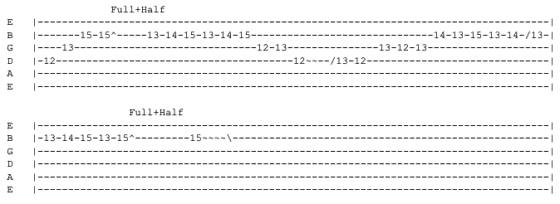Some of the first scales most beginning guitarists learn are the pentatonic scales, five-note scales typically built upon the first, third, fourth, fifth and seventh tones of a major scale. For example, an A pentatonic scale would include the notes A, C, D, E, and G. A typical A pentatonic scale played in one position, starting from the A note on the low E string would sound something like this:

You usually learn the pentatonic scales in a particular key in five different positions (sometimes called boxes) on the neck. You are using the same scale tones in each position, but you are simply starting on a different note. The basic pentatonic scales are great to get under your fingers for blues-based improvisation, or for creating rock or pop solos and riffs.
What most guitar players (including myself, for ten years) fail to realize is that instead of their learning the pentatonic scale, they have only mastered one pentatonic scale. This happens because the basic pentatonic scale sounds good to our ears and is easy to play over many chord progressions. In addition, we go on to learn dozens of other scales, which causes us to think that the pentatonic scale does not hold any more possibilities.
In order to break free of our limiting beliefs about the pentatonic scale, it's only necessary to think about the literal meaning of the word pentatonic. Pentatonic literally means a five-note scale, and this means that, in theory, any five notes of a scale can be chosen by the guitarist to form another new pentatonic scale. In fact, more exotic variations can be made by including a note or two that does not fall within the major scale! Once you understand this concept, you are well on your way to constructing your own, customized pentatonic scales that will energize your solos, and make you stand out from the crowd.
Following are three examples of creating new pentatonic scales based primarily on the D minor (or F major) pentatonic scale, starting on the D note at the 10th fret on the low E string. Each example is played in three octaves. Here is the basic, familiar scale, in just a bit over two octaves:

For example 1, I pulled the seventh note of the scale (C), in favor of a non-scale tone, the flatted fifth, in this case, Ab. Play the scale slowly at first; your fingers seem to naturally want to play the missing C note. Old habits die hard..

Example 1: slow - MP3
Example 2 finds the addition of the second note of the F major scale tone, E, and also a non-scale tone, the sharp seventh, in this case, C#. In order to accomodate these two new notes and keep it to a five-note scale, I had to give two notes the boot. I removed the fifth (A) and the seventh (C) from the scale. It's startin' to sound weird..

Example 2: slow - MP3
Example 3 breaks with all conventions and notions of scalar sanity since two non-scale notes are added, the flatted fifth (Ab) and the sharp seventh (C#). Once again, two notes had to be removed, so the third note (E) and fifth note (A) of the F major scale were unceremoniously dumped.

Example 3: slow - MP3
So, to get started with rolling your own pentatonics, take one of the familiar pentatonic scales in any key and any position and substitute one or more notes with either a scale tone from the major scale or a completely foreign tone outside the scale. I advise you to write down the scale and run through it a few times in three or four octaves. It will help you to familiarize your ear with the exotica you have just invented. If you don't like what you hear, wad up the written scale into a tight ball, toss it into your sister's room, and write another. There are an amazing number of variations that you can try.
Keep in mind also that sometimes the scales you invent don't always sound at their best when simply played as a scale. A lot of times you will only mine the gold from a new scale by playing over a chord progression and testing it out under improvisational conditions. You will probably find that your new scale will sound better if it is inserted at key points in a solo, for a couple of bars, than if you tried to construct an entire 32-bar solo using flatted fifths and sharp sevenths. Then again, maybe not. Let your ear, not your fingers, be your guide.
The next two examples are solos constructed from two of the scales listed above. Example 4 uses the scale from Example 1, and Example 5 uses the scale from Example 3. I don't think I deviated at all from the scale tones, so that you could get a short example of just how these new pentatonics would fit into a solo section.

Example 4: quick - MP3

Example 5: quick - MP3
Dan McAvinchey is a guitarist and composer living in Raleigh, NC.
He believes every musician or composer has the power to write, record and release their own music.